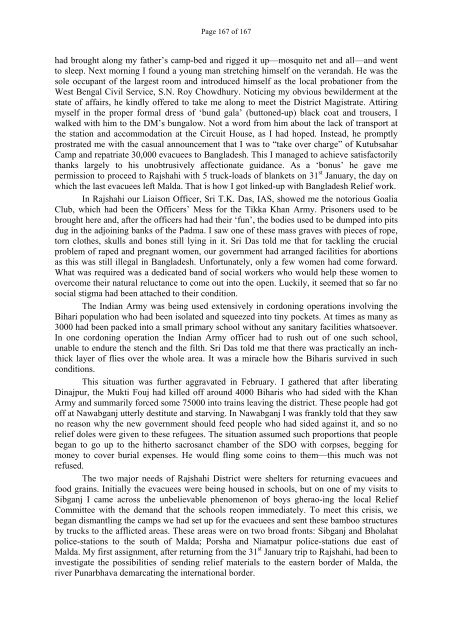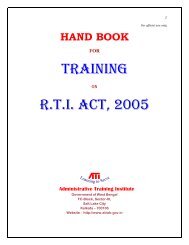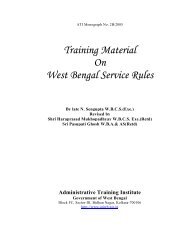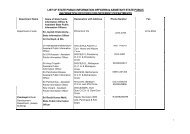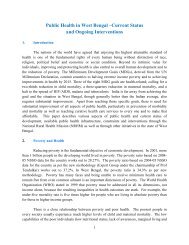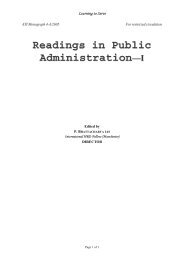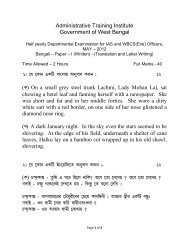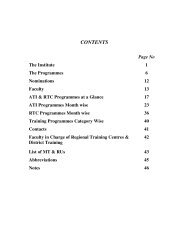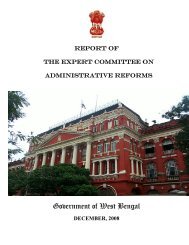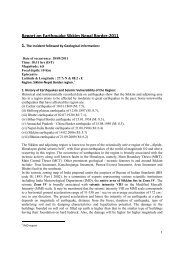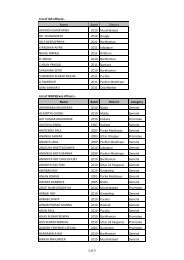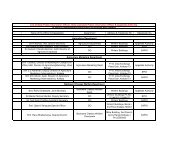Malda Training Diary - Administrative Training Institute
Malda Training Diary - Administrative Training Institute
Malda Training Diary - Administrative Training Institute
You also want an ePaper? Increase the reach of your titles
YUMPU automatically turns print PDFs into web optimized ePapers that Google loves.
Page 167 of 167<br />
had brought along my father’s camp-bed and rigged it up—mosquito net and all—and went<br />
to sleep. Next morning I found a young man stretching himself on the verandah. He was the<br />
sole occupant of the largest room and introduced himself as the local probationer from the<br />
West Bengal Civil Service, S.N. Roy Chowdhury. Noticing my obvious bewilderment at the<br />
state of affairs, he kindly offered to take me along to meet the District Magistrate. Attiring<br />
myself in the proper formal dress of ‘bund gala’ (buttoned-up) black coat and trousers, I<br />
walked with him to the DM’s bungalow. Not a word from him about the lack of transport at<br />
the station and accommodation at the Circuit House, as I had hoped. Instead, he promptly<br />
prostrated me with the casual announcement that I was to “take over charge” of Kutubsahar<br />
Camp and repatriate 30,000 evacuees to Bangladesh. This I managed to achieve satisfactorily<br />
thanks largely to his unobtrusively affectionate guidance. As a ‘bonus’ he gave me<br />
permission to proceed to Rajshahi with 5 truck-loads of blankets on 31 st January, the day on<br />
which the last evacuees left <strong>Malda</strong>. That is how I got linked-up with Bangladesh Relief work.<br />
In Rajshahi our Liaison Officer, Sri T.K. Das, IAS, showed me the notorious Goalia<br />
Club, which had been the Officers’ Mess for the Tikka Khan Army. Prisoners used to be<br />
brought here and, after the officers had had their ‘fun’, the bodies used to be dumped into pits<br />
dug in the adjoining banks of the Padma. I saw one of these mass graves with pieces of rope,<br />
torn clothes, skulls and bones still lying in it. Sri Das told me that for tackling the crucial<br />
problem of raped and pregnant women, our government had arranged facilities for abortions<br />
as this was still illegal in Bangladesh. Unfortunately, only a few women had come forward.<br />
What was required was a dedicated band of social workers who would help these women to<br />
overcome their natural reluctance to come out into the open. Luckily, it seemed that so far no<br />
social stigma had been attached to their condition.<br />
The Indian Army was being used extensively in cordoning operations involving the<br />
Bihari population who had been isolated and squeezed into tiny pockets. At times as many as<br />
3000 had been packed into a small primary school without any sanitary facilities whatsoever.<br />
In one cordoning operation the Indian Army officer had to rush out of one such school,<br />
unable to endure the stench and the filth. Sri Das told me that there was practically an inchthick<br />
layer of flies over the whole area. It was a miracle how the Biharis survived in such<br />
conditions.<br />
This situation was further aggravated in February. I gathered that after liberating<br />
Dinajpur, the Mukti Fouj had killed off around 4000 Biharis who had sided with the Khan<br />
Army and summarily forced some 75000 into trains leaving the district. These people had got<br />
off at Nawabganj utterly destitute and starving. In Nawabganj I was frankly told that they saw<br />
no reason why the new government should feed people who had sided against it, and so no<br />
relief doles were given to these refugees. The situation assumed such proportions that people<br />
began to go up to the hitherto sacrosanct chamber of the SDO with corpses, begging for<br />
money to cover burial expenses. He would fling some coins to them—this much was not<br />
refused.<br />
The two major needs of Rajshahi District were shelters for returning evacuees and<br />
food grains. Initially the evacuees were being housed in schools, but on one of my visits to<br />
Sibganj I came across the unbelievable phenomenon of boys gherao-ing the local Relief<br />
Committee with the demand that the schools reopen immediately. To meet this crisis, we<br />
began dismantling the camps we had set up for the evacuees and sent these bamboo structures<br />
by trucks to the afflicted areas. These areas were on two broad fronts: Sibganj and Bholahat<br />
police-stations to the south of <strong>Malda</strong>; Porsha and Niamatpur police-stations due east of<br />
<strong>Malda</strong>. My first assignment, after returning from the 31 st January trip to Rajshahi, had been to<br />
investigate the possibilities of sending relief materials to the eastern border of <strong>Malda</strong>, the<br />
river Punarbhava demarcating the international border.


